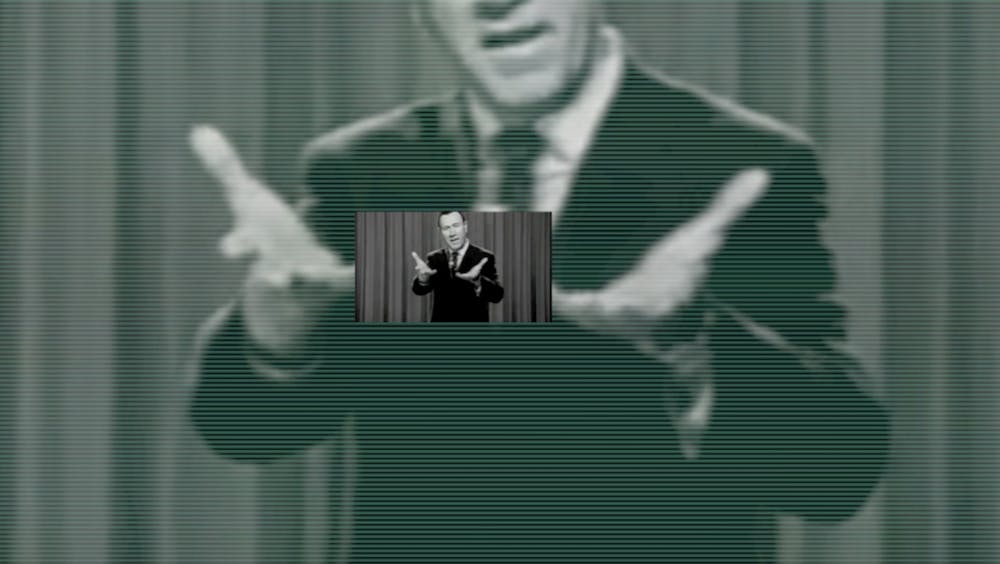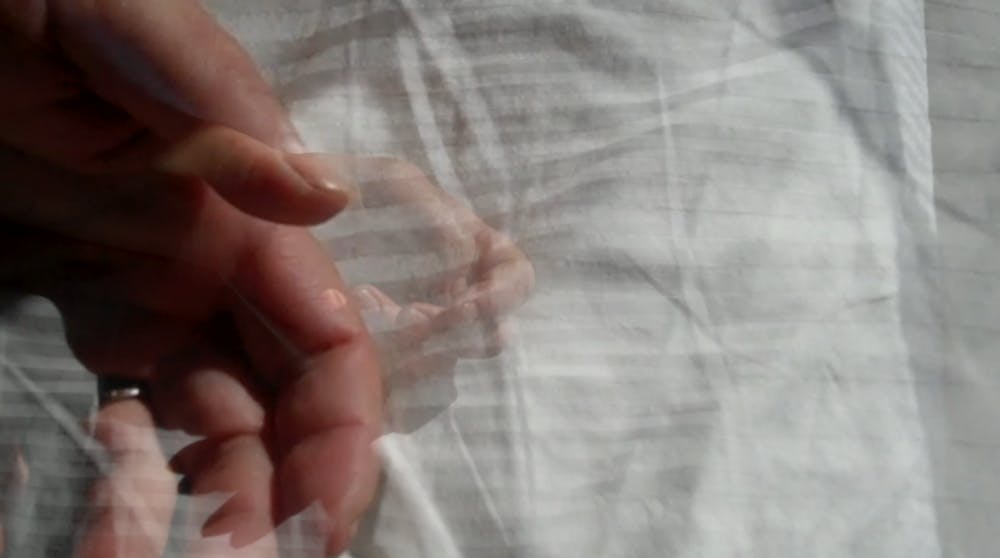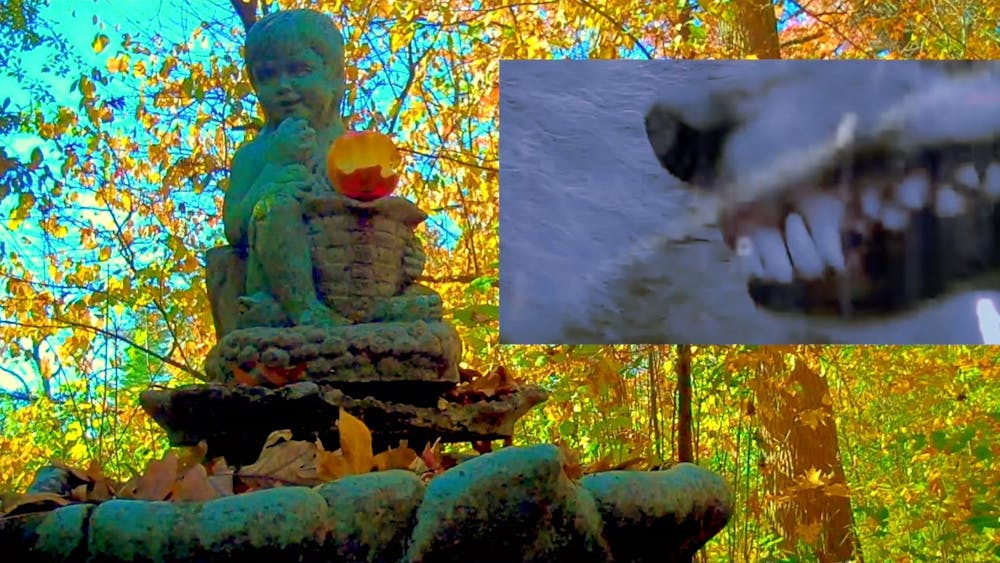View Matt Mullins' video poetry on his Vimeo page.
Matt Mullins said he discovered film literature through “a series of happy accidents.”
Inspired by artists like Jim Morrison and The Doors, Mullins wrote song lyrics when he was in high school. While he wasn’t a “huge reader” of poetry at the time, he knew the lyrics he was writing were a form of the written genre.
Mullins, Ball State associate professor of English, was officially introduced to the world of creative writing as a sophomore at Michigan State University, where he originally studied as a communications major. He later switched his major to English after an introductory class to creative writing “changed the whole course of [his] life.”
Not only did he start writing poetry in this class, Mullins said, but his professor also had him experimenting with various types of poetry, and he read from a wide variety of poets.
After graduating from Michigan State with a bachelor's degree in English and creative writing in the spring of 1990 and earning his masters of fine arts at Western Michigan University in 1998, Mullins worked as the senior editor writer for a boutique interactive media company out of Detroit called Sigma Six, where he became a “multi-genre man.”
“That’s where I started getting interested in digital technologies and the visual side of things,” Mullins said. “I had all these skills in terms of making music, recording music, and visualizing what things might look like, and recording those and then playing with those and editing software while I was writing poetry, and fiction and screenplay.”

Matt Mullins, Photo Provided
Mullins took his “unique skill set of interests” and became an emerging media fellow at Ball State in 2008. While working on his project of creating the digital interactive literary interfaces, he said, a colleague of his introduced him to Michael Pounds, a professor of music theory and composition.
“He’s kind of an avant garde composer,” Mullins said.
Pounds said he creates music, or sound art, “by heavily processing and transforming sounds.” When he met Mullins, Pounds said, he was looking for collaborators to pair his music with their art.
“He wanted to work on a project with me where he was creating a composition for the symposium that was coming up,” Mullins said. “He said, ‘I’d really like to set this piece that I’m writing to some work, some language. Do you want to collaborate with me on something like this?’”
At the time, Mullins said, he was working on his book, “Three Ways of the Saw,” in which he published a short story titled “Highway Coda.” The story follows jazz musicians returning from a gig when they see a box of takeout Chinese food in the middle of the road. A crow swoops down, picks up the box by its metal handle and flies away with it before the musicians could run it over.
“It’s about synchronicity, timing and improvisation,” Mullins said. “That was the piece that I decided I wanted to collaborate with [Pounds] on for what he was submitting to the symposium.”
Pounds later asked Mullins to join him at the conference at which the symposium was held, where Pounds hoped Mullins would be willing to recite his writing over Pounds’ composition. Before he shared their project publicly, Mullins said, he knew deep down it needed something more to it.
Mullins considered his other skills and interests, specifically the ones he had developed while working at Sigma Six, and came up with the idea of creating a movie out of his collaboration with Pounds. Mullins recorded himself reading “Highway Coda,” put his reading over images he felt fit with the story and Pounds’ music and created a short film about six minutes long.

Matt Mullins, Photo Provided
“After hearing the audio piece I created, Matt created a video to go along with it,” Pounds said. “I had Matt come to the studios, and I recorded him reading his poem. I also recorded him playing some guitar — some drums too — and I think there is some bass as well.”
The six-minute video Mullins created with Pounds’ recordings was the first stop on a decade-long journey in the world of film literature.
“That [process] was kind of a revelation,” Mullins said. “That was when I discovered that there’s a whole world out there, this whole subgenre of poetry — video poetry or film cinema.”
As a somewhat new hire at Ball State and a creative writing professor himself at the time, Mullins said, he began to consider how he could apply his newfound affinity for film poetry to tenure.
Occasionally, Mullins said, professors in the English department have the opportunity to teach a special topics course. When Mullins was offered the chance to teach ENG 405, he decided he wanted to teach a workshop on how to create film poetry.
Mullins’ class was offered three semesters ago during fall 2019. Katelynn Gossage, graduate student in student affairs administration in higher education, said she had an open elective slot in her schedule that semester. Gossage emailed Mullins to ask him what the focus of his class would be, she said, and his response inspired her to sign up.
“The way that he described it was just really cool,” Gossage said. “He talked about having your own multimedia project, so I stuck with that class and decided not to switch.”
Gossage was familiar with writing before taking Mullins’ course, she said, but video poetry was a completely new topic for her to explore. Poetry was not her “strong suit,” she said, but Mullins helped her and his other students learn to find what worked best for them.
“Dr. Mullins made it very easy to experiment and put myself out there in some experimental ways that I wasn’t always comfortable with,” Gossage said. “When you’re not comfortable, that’s when you grow.”

Matt Mullins, Photo Provided
Noah Davis-Cheshire, a 2020 Ball State graduate who majored in creative writing and intermedia art, also took Mullins’ video poetry course in the fall 2019 semester. While searching through the English course catalog to see what courses would fulfill his requirements, he said, he came across Mullins’ course and thought the concept was a perfect combination of his majors.
“It felt like I really had to take it because it was such a bizarre intersection of my two areas of academic study,” Davis-Cheshire said. “I just had to learn more.”
Mullins’ course was the first creative writing class that allowed Davis-Cheshire to work on video art and combine his two interests, he said, and it allowed him to see how video art could be shaped as approached from the perspective of a writer versus the perspective of an intermedia artist.
“Putting poetry first and trying to find imagery that contrasts or adds an additional meaning to the words and using those words as a foundation was just an excellent opportunity,” Davis-Cheshire said. “It was a chance to see some really interesting work that I hadn’t had a chance to see before.”
In his course, Mullins said, he taught his students the process of creating film literature from start to finish. Contrary to what some may believe, he said, not all video poetry starts with a poem, but each project is about finding an “opening” in a poem that allows for the creation of what Mullins refers to as a “third thing.”
“I look for poems that seem to have the ability to have that kind of space and play opened up inside them,” Mullins said. “If it’s a poem that is already existing, I look for that space. If it’s one I’m writing, I try to create that space. If it’s one that I see that I want to perhaps approach, I think for ways into that space. In the end, what I look for is a subtextual openness or possibility that allows me to approach the poem in a non-literal way. I think being non-literal is the most interesting way to approach video poetry.
“I look for a way into the poem. Good video poetry for me is often about subtext. As I’ve tried to progress in my work, it’s less about literally representing what the poem is talking about and more about showing things that create this third thing, this subtext, an idea.”

Matt Mullins, Photo Provided
Because the students in his course had so much creative freedom, Mullins said it allowed them to not only discover what worked best for them, but to grow individually as both writers and artists.
“What I found surprising is the wide range of invention and the skills of my students,” Mullins said. “They never cease to surprise me in terms of the things they come up with, their abilities. Both their skills and their inventiveness are the things that I think over the years in terms of teaching creative writing have surprised me the most.”
Both Gossage and Davis-Cheshire said one of the biggest takeaways from Mullins and his video poetry course was the ability to combine so many creative elements into one project. For Gossage, the classroom was a comfortable place for her to share her ideas and turn them into something visual.
“I’m a very visual person, so when I think of ideas, or create a metaphor or something like that, there’s usually another picture that comes along with it,” Gossage said. “The great thing about video poetry was that I was able to sometimes take those metaphors that I could only see in my head and show them to my audience.”
Which, in essence, is the entire purpose of film poetry, Mullins said, giving “extra sensory input that you’re not getting when you’re reading it on the page.”
“There’s no substitute for poetry on the page — it’s ancient, and it’s beautiful and it will endure, and that’s marvelous,” Mullins said. “Video poetry takes it to a different place. As you read a poem on the page, your mind creates the visual images. Your mind can [create] the images that you’re reading.”
Mullins said he hopes for the genre of film literature to continue to grow, especially in the United States. As a co-curator of the Juteback poetry film festival and the mixed media editor of the Atticus Review, an online literary magazine, Mullins works to increase awareness of mixed media art and hopes to continue doing so.
“My hope is that [video poetry] continues to be interesting and vital,” Mullins said. “I hope that I am still inspired to make it. I hope I progress in how I make it — getting better, evolving in interesting ways, discovering more and learning new approaches. I hope to grow in skill. I hope to grow in output. I hope to grow in exposure.”
Contact Taylor Smith with comments at tnsmith6@bsu.edu or on Twitter @taynsmithh.





